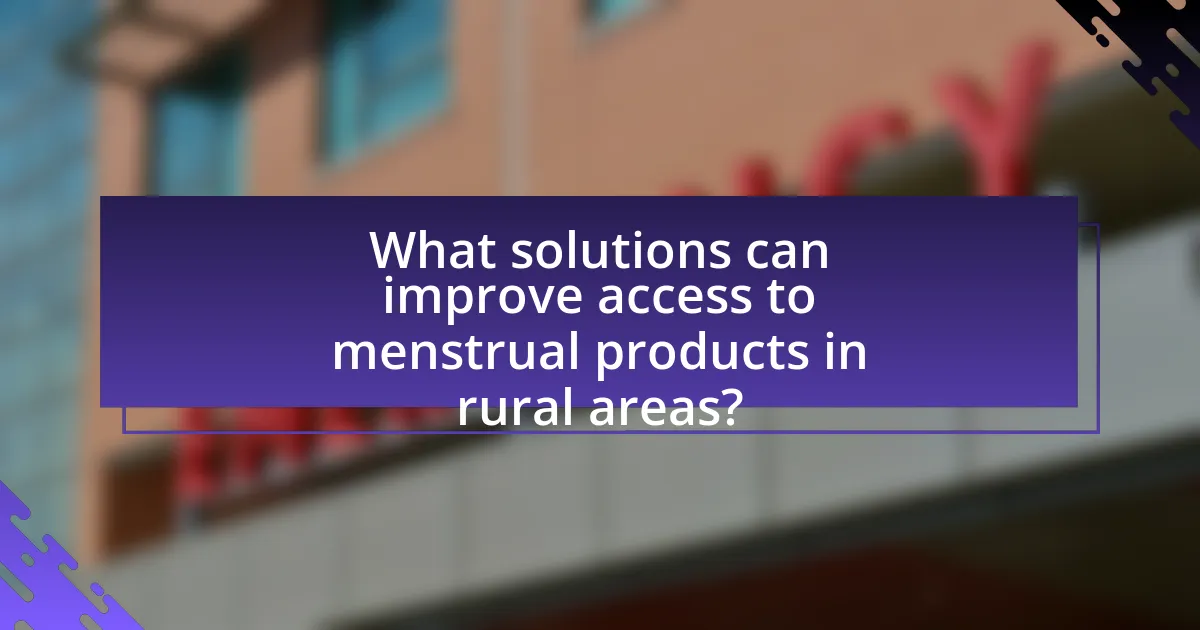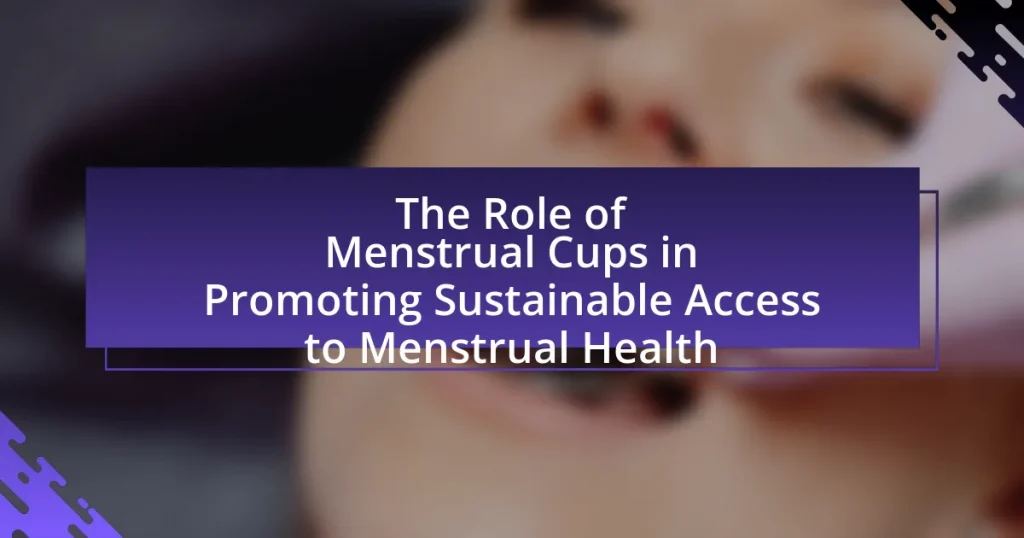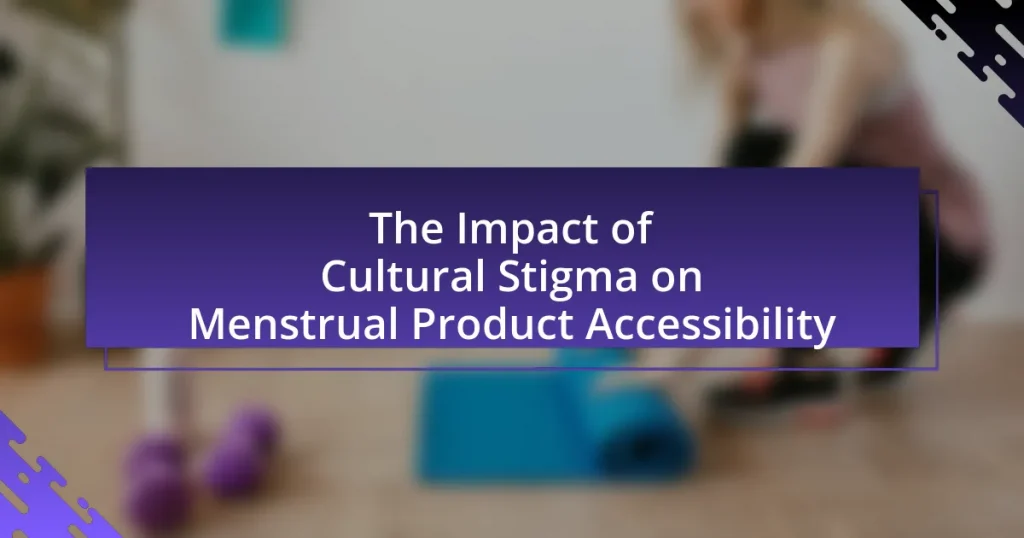The article focuses on the barriers to accessing menstrual products in rural areas, highlighting key challenges such as limited availability, high costs, lack of transportation, and cultural stigma. Geographical factors, including distance to stores and inadequate transportation infrastructure, further complicate access. Socio-economic issues, such as poverty and lack of education, contribute to the difficulties faced by individuals in obtaining necessary menstrual hygiene products. The article also examines the implications of limited access on women’s health, education, and economic participation, while proposing solutions like community initiatives and government policies to improve accessibility.

What are the main barriers to accessing menstrual products in rural areas?
The main barriers to accessing menstrual products in rural areas include limited availability, high costs, lack of transportation, and cultural stigma. Limited availability arises from fewer retail outlets in rural regions, making it difficult for individuals to find menstrual products. High costs can deter purchases, especially in low-income communities where affordability is a significant concern. Lack of transportation further complicates access, as individuals may need to travel long distances to reach stores that sell these products. Cultural stigma surrounding menstruation often leads to silence and shame, preventing open discussions about menstrual health and product needs. These factors collectively hinder access to essential menstrual products for those living in rural areas.
How do geographical factors influence access to menstrual products?
Geographical factors significantly influence access to menstrual products by determining the availability of retail outlets and distribution networks. In rural areas, limited transportation infrastructure and fewer stores result in reduced access to these essential products. For instance, a study by the World Bank indicated that women in rural regions often travel long distances to purchase menstrual products, which can lead to delays and increased costs. Additionally, cultural norms in certain geographical locations may restrict discussions about menstruation, further complicating access. These factors collectively create barriers that hinder women’s ability to obtain menstrual products consistently and conveniently.
What role does distance to stores play in product availability?
Distance to stores significantly impacts product availability, particularly for menstrual products in rural areas. Research indicates that greater distances to retail outlets correlate with lower access to essential items, as individuals may face challenges in traveling long distances to purchase these products. A study published in the Journal of Rural Health found that women living more than 10 miles from a store reported higher instances of product unavailability, highlighting the direct relationship between distance and access. This evidence underscores the critical role that proximity to stores plays in ensuring the availability of menstrual products for those in rural communities.
How does transportation affect access to menstrual products?
Transportation significantly affects access to menstrual products by limiting the ability of individuals in rural areas to reach stores or healthcare facilities that supply these essential items. In many rural regions, inadequate transportation infrastructure, such as poorly maintained roads or lack of public transit, restricts access to retailers that stock menstrual products. For instance, a study by the World Health Organization found that women in rural areas often travel over 30 miles to access basic health services, which includes purchasing menstrual hygiene products. This distance can lead to delays in obtaining necessary supplies, resulting in increased stress and health risks associated with inadequate menstrual management.
What socio-economic factors contribute to the barriers?
Socio-economic factors that contribute to barriers in accessing menstrual products in rural areas include poverty, lack of education, and limited transportation options. Poverty restricts financial resources, making it difficult for individuals to afford menstrual products. According to a study by the World Bank, approximately 9.2% of the global population lives on less than $1.90 a day, which significantly impacts their ability to purchase essential items like menstrual hygiene products. Lack of education leads to misinformation about menstrual health and hygiene, further exacerbating the issue. The United Nations Educational, Scientific and Cultural Organization (UNESCO) reports that girls in low-income areas often miss school during their periods due to inadequate access to menstrual products, which perpetuates the cycle of poverty and limits future opportunities. Additionally, limited transportation options in rural areas hinder access to stores that sell these products, as highlighted in research by the International Journal of Environmental Research and Public Health, which emphasizes the correlation between transportation accessibility and the availability of menstrual hygiene products.
How does income level impact the ability to purchase menstrual products?
Income level significantly impacts the ability to purchase menstrual products, as lower income restricts access to necessary hygiene items. Individuals with limited financial resources often prioritize essential needs such as food and shelter over menstrual products, leading to inadequate access. According to a study published in the Journal of Global Health, 1 in 5 low-income women reported missing work or school due to lack of access to menstrual products, highlighting the direct correlation between income and product availability. Furthermore, the cost of menstrual products can consume a substantial portion of a low-income individual’s budget, exacerbating the challenge of maintaining menstrual health.
What is the effect of education on awareness and access to menstrual products?
Education significantly enhances awareness and access to menstrual products. Individuals with higher levels of education are more likely to understand menstrual health, leading to increased knowledge about available products and their proper use. Research indicates that educated women are more likely to advocate for their menstrual health needs and seek out necessary resources. For instance, a study published in the Journal of Adolescent Health found that girls who received comprehensive menstrual education were 1.5 times more likely to use sanitary products compared to those who did not receive such education. This correlation underscores the critical role education plays in breaking down barriers to accessing menstrual products, particularly in rural areas where stigma and misinformation may prevail.
How do cultural attitudes shape the accessibility of menstrual products?
Cultural attitudes significantly influence the accessibility of menstrual products by shaping perceptions, stigmas, and policies surrounding menstruation. In many societies, negative cultural beliefs about menstruation can lead to shame and secrecy, discouraging open discussions and education about menstrual health. For instance, in some rural areas, traditional views may deem menstruation as unclean, resulting in limited availability of menstrual products in local markets. Furthermore, cultural norms can affect the prioritization of resources; in communities where menstruation is not openly acknowledged, funding for menstrual health initiatives may be minimal, leading to inadequate supply chains. Research indicates that in regions with strong taboos against menstruation, such as parts of South Asia, girls often miss school during their periods due to lack of access to products, which perpetuates gender inequality and hinders educational opportunities. Thus, cultural attitudes directly impact both the availability and the social acceptance of menstrual products, creating barriers to access in rural areas.
What stigmas exist around menstruation in rural communities?
Stigmas around menstruation in rural communities often include beliefs that menstruating individuals are impure or unclean, leading to social exclusion during their menstrual cycle. These stigmas can manifest in practices such as restricting access to certain spaces, prohibiting participation in community activities, and fostering feelings of shame and embarrassment. Research indicates that in many rural areas, cultural norms dictate that menstruation is a taboo subject, resulting in a lack of education and open discussion about menstrual health. For instance, a study published in the journal “BMC Women’s Health” highlights that misconceptions about menstruation contribute to the stigma, which in turn affects the ability of individuals to access necessary menstrual products and healthcare.
How do cultural beliefs influence the use of menstrual products?
Cultural beliefs significantly influence the use of menstrual products by shaping perceptions of menstruation and determining acceptable practices. In many cultures, menstruation is surrounded by taboos that dictate which products are deemed appropriate, often favoring traditional options like cloth over modern sanitary products due to beliefs about purity and hygiene. For instance, in some rural areas of India, cultural norms discourage the use of commercial menstrual products, leading to a reliance on homemade alternatives, which can affect health outcomes. Studies indicate that these beliefs can result in lower usage rates of sanitary pads, with only 12% of menstruators in India using them, primarily due to stigma and lack of education surrounding menstrual health.

What are the implications of limited access to menstrual products?
Limited access to menstrual products leads to significant health, social, and economic implications for individuals and communities. Health-wise, inadequate access can result in increased risk of infections and reproductive health issues, as individuals may resort to unsafe alternatives during menstruation. Socially, the stigma surrounding menstruation can be exacerbated, leading to absenteeism from school or work, which affects education and economic productivity. Economically, the inability to manage menstruation effectively can hinder women’s participation in the workforce, contributing to broader gender inequality. According to a study by the World Bank, 1 in 10 girls in Africa misses school during their menstrual cycle due to lack of access to sanitary products, highlighting the educational impact of this issue.
How does inadequate access affect women’s health?
Inadequate access to menstrual products significantly affects women’s health by leading to increased rates of reproductive health issues and mental health challenges. Women in rural areas often face barriers such as lack of availability, affordability, and education regarding menstrual hygiene, which can result in the use of unsafe materials during menstruation. Research indicates that inadequate menstrual hygiene management can lead to infections, reproductive tract disorders, and increased absenteeism from school or work, ultimately impacting women’s overall well-being and economic stability. A study published in the Journal of Global Health found that 1 in 10 girls in Africa miss school during their menstrual cycle due to lack of access to sanitary products, highlighting the broader implications of inadequate access on women’s health and education.
What are the potential health risks associated with using unsafe menstrual products?
Using unsafe menstrual products can lead to several health risks, including toxic shock syndrome (TSS), infections, and allergic reactions. TSS, a rare but serious condition, is associated with the use of certain types of tampons and can result in severe complications, including organ failure. Infections can arise from the use of unsterilized or contaminated products, leading to conditions such as bacterial vaginosis or urinary tract infections. Additionally, some menstrual products may contain harmful chemicals or allergens that can cause skin irritations or allergic reactions. Studies have shown that the use of unsafe products significantly increases the likelihood of these health issues, emphasizing the importance of access to safe menstrual hygiene products.
How does limited access impact mental health and well-being?
Limited access to menstrual products significantly impacts mental health and well-being by contributing to feelings of shame, anxiety, and social isolation. Research indicates that individuals who cannot access necessary menstrual hygiene products often experience increased stress and lower self-esteem, which can lead to broader mental health issues such as depression. A study published in the Journal of Adolescent Health found that girls in low-income areas reported higher levels of anxiety and missed school due to menstruation-related challenges, highlighting the direct correlation between access to menstrual products and mental health outcomes.
What are the broader social implications of restricted access?
Restricted access to menstrual products in rural areas leads to significant social implications, including increased stigma around menstruation and exacerbated gender inequality. Women and girls facing limited access often miss school or work, which can hinder their education and economic opportunities. According to a study by the World Bank, 1 in 10 girls in Africa misses school during their menstrual cycle, highlighting the impact on educational attainment. Furthermore, restricted access can contribute to health issues, as inadequate menstrual hygiene management increases the risk of infections. This situation perpetuates a cycle of poverty and marginalization, reinforcing societal norms that devalue women’s health and well-being.
How does lack of access affect women’s participation in education and work?
Lack of access significantly hinders women’s participation in education and work by creating barriers that prevent them from fully engaging in these essential areas. For instance, when women do not have reliable access to menstrual products, they may miss school or work due to discomfort or embarrassment, leading to lower educational attainment and reduced job opportunities. Research indicates that girls in low-income areas often miss up to 20% of school days due to menstruation-related issues, which directly impacts their academic performance and future employment prospects. Furthermore, the World Bank reports that women’s economic participation can increase by 30% if barriers related to menstrual health are addressed, highlighting the critical link between access to menstrual products and women’s ability to participate in education and the workforce.
What are the economic consequences for communities with limited access?
Communities with limited access to menstrual products face significant economic consequences, including increased healthcare costs and reduced workforce participation. The lack of access leads to health issues such as infections and reproductive complications, which can result in higher medical expenses for individuals and healthcare systems. Additionally, when individuals miss work or school due to inadequate menstrual hygiene management, productivity declines, leading to economic losses for both families and local economies. Research indicates that women who lack access to menstrual products are more likely to experience absenteeism, which can hinder economic growth in these communities.

What solutions can improve access to menstrual products in rural areas?
Improving access to menstrual products in rural areas can be achieved through mobile distribution programs that deliver products directly to communities. These programs can partner with local health workers or organizations to ensure that menstrual products are available at health clinics, schools, and community centers. Research indicates that mobile health initiatives have successfully increased access to essential health products in underserved areas, demonstrating their effectiveness in reaching populations that face logistical challenges. Additionally, implementing educational campaigns to raise awareness about menstrual health can empower individuals to seek out and utilize available resources, further enhancing access.
How can community initiatives enhance access to menstrual products?
Community initiatives can enhance access to menstrual products by establishing local distribution points and educational programs. These initiatives often involve partnerships with local organizations to create awareness about menstrual health and provide free or subsidized products. For example, studies have shown that community-led programs in rural areas can significantly reduce the stigma surrounding menstruation and increase the availability of products, leading to improved health outcomes for women and girls. In regions where access to menstrual products is limited, initiatives like mobile distribution units or community workshops have proven effective in reaching underserved populations, thereby addressing both logistical and educational barriers.
What role do local organizations play in distributing menstrual products?
Local organizations play a crucial role in distributing menstrual products by addressing accessibility issues in rural areas. These organizations often identify the specific needs of their communities and implement targeted distribution strategies, such as setting up local distribution points or partnering with schools and health clinics. For instance, studies have shown that community-based initiatives can significantly increase access to menstrual products, with organizations like Days for Girls providing over 1 million menstrual kits globally, thereby reducing stigma and improving health outcomes.
How can awareness campaigns change perceptions and improve access?
Awareness campaigns can change perceptions and improve access to menstrual products by educating communities about menstrual health and reducing stigma. These campaigns often utilize targeted messaging to inform individuals about the importance of menstrual hygiene, which can lead to increased acceptance and understanding within communities. For instance, a study published in the Journal of Adolescent Health found that educational interventions significantly increased knowledge about menstruation and improved attitudes towards menstrual health, resulting in greater access to products in rural areas. By addressing misconceptions and promoting open discussions, awareness campaigns can effectively dismantle barriers that hinder access to essential menstrual products.
What policies can governments implement to support access to menstrual products?
Governments can implement policies such as subsidizing menstrual products, providing free access in schools and community centers, and ensuring tax exemptions on these products. Subsidizing menstrual products can reduce costs for consumers, making them more affordable, especially in rural areas where access may be limited. Providing free access in schools and community centers ensures that individuals who may not have the means to purchase these products can still obtain them, thereby promoting health and hygiene. Additionally, tax exemptions can lower the overall price of menstrual products, further enhancing accessibility. These measures are supported by studies indicating that financial barriers significantly impact access to menstrual products, particularly in underserved communities.
How can subsidies or free distribution programs help those in need?
Subsidies or free distribution programs can significantly alleviate the financial burden of menstrual products for those in need. By reducing or eliminating costs, these initiatives ensure that individuals, particularly in rural areas, have access to essential hygiene products, which is crucial for health and dignity. For instance, a study by the World Bank found that when menstrual products are subsidized, school attendance among girls increases by up to 20%, demonstrating the direct impact of financial support on accessibility.
What regulations can ensure the availability of safe menstrual products?
Regulations that can ensure the availability of safe menstrual products include mandatory safety standards for product manufacturing, labeling requirements for ingredients, and government subsidies for low-income populations. These regulations help guarantee that menstrual products are free from harmful chemicals and are produced under hygienic conditions. For instance, the FDA in the United States regulates menstrual products under the Federal Food, Drug, and Cosmetic Act, ensuring that they meet safety and effectiveness standards. Additionally, countries like Canada have implemented the Menstrual Products Act, which mandates that menstrual products be safe and accessible, particularly for marginalized communities. Such regulations are crucial for promoting public health and ensuring that all individuals have access to safe menstrual hygiene products.
What practical steps can individuals take to address these barriers?
Individuals can address barriers to accessing menstrual products in rural areas by advocating for local policy changes that improve distribution and availability. Engaging with community leaders to establish partnerships with organizations that provide menstrual health education and product distribution can enhance access. Additionally, individuals can organize community drives to collect and distribute menstrual products, ensuring that those in need receive them directly. Research indicates that community-based initiatives significantly increase awareness and access to menstrual products, as seen in programs implemented in various rural regions.
How can individuals advocate for better access to menstrual products in their communities?
Individuals can advocate for better access to menstrual products in their communities by organizing awareness campaigns and collaborating with local organizations. These efforts can include hosting educational workshops to inform the public about menstrual health and the importance of access to products, which can help reduce stigma and increase understanding. Additionally, individuals can engage with local policymakers to promote legislation that supports the distribution of menstrual products in schools, shelters, and community centers. Research indicates that in the United States, 1 in 5 teens have missed school due to a lack of access to menstrual products, highlighting the urgent need for advocacy in this area. By leveraging statistics and personal stories, advocates can effectively communicate the necessity of improved access to menstrual products, thereby fostering community support and driving change.
What are some effective ways to educate others about menstrual health and access?
Effective ways to educate others about menstrual health and access include community workshops, school-based programs, and social media campaigns. Community workshops can provide hands-on education and foster open discussions, which are essential for breaking stigma. School-based programs can integrate menstrual health education into the curriculum, reaching young people directly; studies show that comprehensive education can improve knowledge and attitudes towards menstruation. Social media campaigns can leverage platforms to disseminate information widely, utilizing statistics that indicate 1 in 4 girls in the U.S. have missed school due to lack of access to menstrual products, highlighting the urgency of the issue.



